There are differences in farming when it comes to poultry and dairy. Even within the dairy and poultry farms, there are various types of livestock and ways of farming.
Dairy farming is when dairy cattle, goats, buffalo, and more, are raised for long-term milk production. Poultry farming is raising chickens, ducks, geese, turkeys, and other domesticated fowl, including ostriches, for their meat and eggs as food sources.
If you want to explore the differences between dairy farming and poultry farming, you have come to the right place. We will discuss the types of poultry and dairy farms, what goes into dairy and poultry farming, and how they compare to one another.
Dairy Farming vs. Poultry Farming: What are the Differences
The key difference between dairy farming and poultry farming is the type of livestock being raised and the purpose for which it is raised. With poultry farming, you are raising birds as food sources, such as eggs or meat. With dairy, you are raising animals, usually cattle, for milk production.
Things to consider between both types of farming are:
When discussing dairy and poultry, there is a large variety of animals that fit into these categories. Even within these categories, there can be differences in how and why the animals are raised. Let’s explore these farms and get a better idea of how they compare.
Dairy Farm Animals vs. Poultry Farm Animals
Dairy Farm Animals
Dairy farms are for the raising of milk-producing animals to supply milk to the consumer population. The animal’s milk is collected and sold for food consumption or processed into a variety of foods. There are a few different types of dairy animals. The most popular is the dairy cow. Here is the list of some common and less common dairy animals that are farmed for their milk.
Common Dairy Animals | Less Common Dairy Animals |
|---|---|
Each of these animals requires different types of care. They are often very expensive and must have enough land to sustain them.
This article will focus on dairy cows because of their popularity and demand for cow milk globally.
Poultry Farm Animals
Poultry farms are where birds are raised for their eggs and meat. There are many types of fowl one might consider for a poultry farm. The list below is far from complete, but it gives an idea of what types of fowl people farm.

Cornish Game Hen-Cooked
We will be focusing on chicken poultry farms in this article. Chickens are by far the most popular of these poultry farm animals. They are relatively inexpensive to buy. Many towns have begun allowing people to have a laying hen or two within city limits, making them an ideal food source animal for almost anyone.
Common illnesses: Dairy Farm Animals vs. Poultry Farm Animals
Illnesses can be a considerable hurdle in a dairy or poultry farm. Listed below are some illnesses that farms may have to face:
Dairy Farm Animals
Poultry Farm Animals
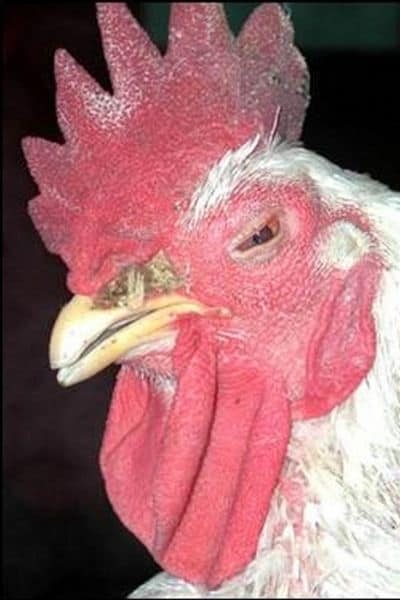
Mycoplasmosis in Chicken (Source: https://www.msdvetmanual.com/)
Types of Dairy and Poultry Farms
There are different types of dairy farms and poultry farms. The dairy farm has three types, while the main objective is the same; raising the dairy cows to produce milk to sell. There are also three types of poultry farms. The poultry farms are divided into the purpose of the bird, such as egg layers or meat birds.
Dairy Farm Types
According to Dairy Discovery there are three popular types of dairy farms. These are the:
Freestall

Freestall barns are open, allowing the cows to move through at their will, and choose the stall they will lay down in. They can eat when they want and rest when they want. This type of barn has excellent ventilation. They help keep the cows comfortable in summer and winter.
Pasture
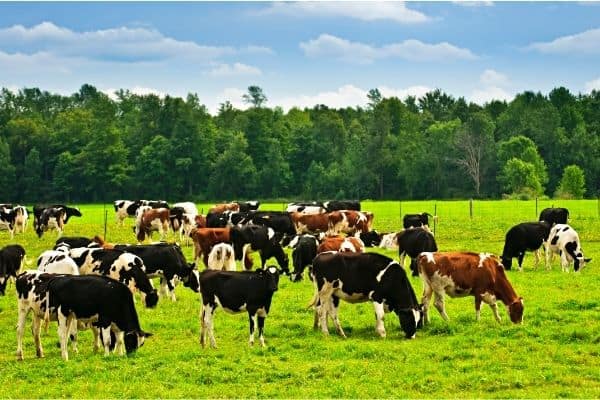
The pasture dairy farm allows the cows to roam and graze the pasture when they are not being milked. They still have shelters for harsh weather conditions, and food is provided to them within barns. However, the majority of their time is spent resting and eating in the pasture.
Dry Lot

The dry lot dairy is the choice for dairy farms in dry climates. The dairy cows can take shelter from the sun. They walk freely to the feed shelter that has misters going, to keep them cool, and they are taken to the milking barn three times a day.
Each of these types of farms takes into consideration the comfort of the cows in the environment they are raised.
Poultry Farm Types
There are three types of poultry chicken farms. These farms also vary in design depending on the climate of the poultry farm and how large the farm is.
Broiler Farm

On a broiler farm, birds are raised for their meat. These birds are genetically chosen for their ability to turn feed into meat production.
Meat chickens can convert two pounds of feed to one pound of meat, according to Poultry reporter. Broiler chickens often grow very fast and will reach at least five pounds by eight weeks of age.
The types of chickens at broiler farms are raised for meat consumption only. Therefore only certain types of chickens are grown. These would be the Cornish Rock Cross.
Breeder Farm
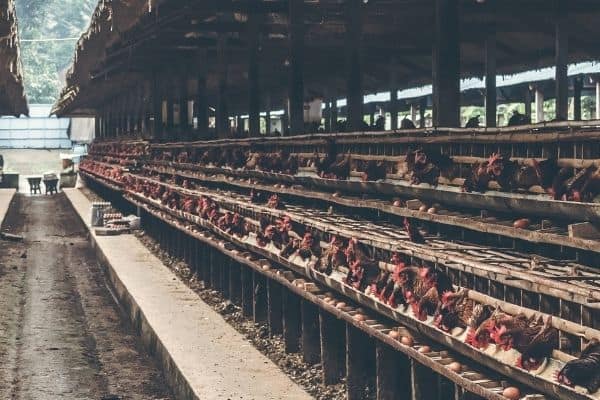
Breeder farms are farms where the broiler chickens and layers are bred for the market. The broiler fertilized eggs are collected and incubated until they are hatched. The chicks are then sent to the broiler farm, where they will be raised until they are ready for butcher. The layers are bred and distributed to layer farms.
Egg Farm

Layer farms raise hens that lay eggs for consumption. With commercial egg farming, the farmers receive the hens as freshly hatched chicks from a hatchery. They are raised in staged housing. Egg farming can be done on a backyard scale up to a commercial scale.
For the health of the animals, they need to be comfortable and clean. The chickens need to have access to food and water at all times. Their living environment needs to keep them cool in hot weather and warm in cold weather.
Dairy Farm vs. Poultry Farm Products
Moving on from the animals used for production, we now look at the products produced from those animals. The main product difference is meat vs. milk.
Dairy farms use their animal of choice to produce milk, and that milk is used to make many products such as:
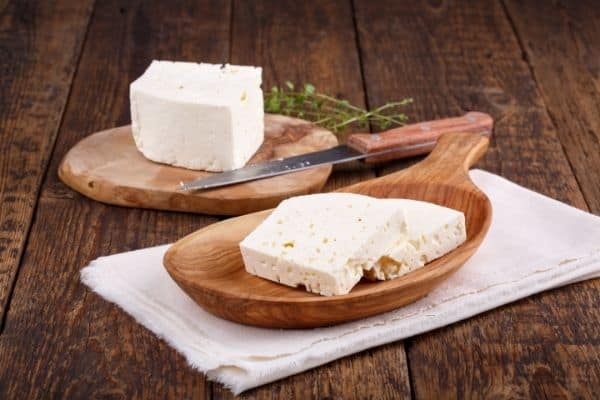
White cheese from Cow milk
Meanwhile, poultry farms produce different products from their animals. Basically, you get a couple of products like:
How Much Land is Needed?
This depends on how large a farm you intend to have, as much as what you will be farming. Chickens and Cows are very different in mass and land need. Also, most city ordinances would not allow a cow in the city, but many will allow chickens. This gives some perspective on the amount of land required.
How much Space do you need for Poultry Farm?
For chickens, the rule of thumb is to give each bird at least 2 square feet within the coop and at least 8 square feet in an outdoor run. This will provide the birds with plenty of space so they are not stressed. In addition, it will reduce the pecking of each other, which could result in death and or cannibalism.
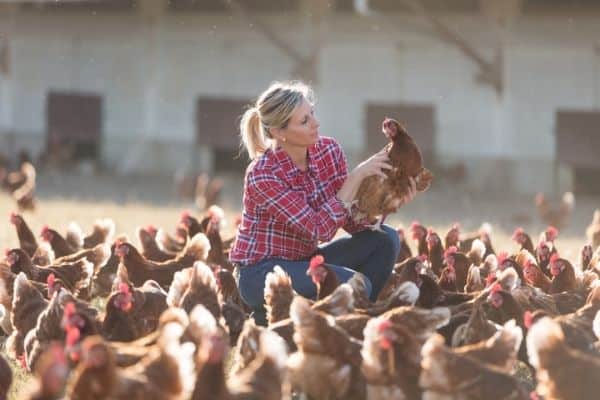
Farming poultry on a large scale often means these space requirements are not as closely followed, and many chickens may be packed within a single cage or house.
How much Space do you need for Dairy Farm?
Dairy cows require a much larger amount of space per cow. There are many methods for determining exactly how much land you would need per cow. However, it is usually recommended that a single dairy cow requires just under 2 acres for grazing alone.
What Kind of Housing is Required?
Again, this will be determined by the size of your herd or flock and how much land you have available. It is guaranteed that you will need more extensive facilities to care for your dairy cows than for your poultry; unless you’re raising ostriches.
Dairy Farm Housing
Dairy barns need to be large enough for the herd to walk in or out of the barn. Stalls must be comfortable and accommodating. Dairies often have a staged animal production, and this requires separate space for cows that are:
- Pregnant
- In milk
- Dry
These are the natural cycles of dairy cows. However, in each cycle, the cows require different amounts and types of feed to ensure proper growth and production. Therefore it is essential to separate them.
Depending on the herd size, you may need three barn style shelters; you may also need a shelter for sick animals and an area for artificial insemination.
We discussed some of the types of dairies above. The dairy types are really about how the cows are housed. For any of the types:
- Drylot
- Pasture
- Freestall
Your farm will also require a milking barn. If you only have one cow, you can get away with a small barn such as Farm Fresh for Life built. It is nothing fancy. It has old-school hand milking equipment and cement floors for easy clean-up. Climate control would be easily installed in a small barn such as this.

Rotary Milking Parlor
If you want to get more information on milking parlors, check our article on popular milking parlors for dairy farms.
When it comes to milking many cows at once, it is essential to have your milk parlor designed with adequate efficiency. The comfort of the animal is again the top priority.
Poultry Farm Housing
Poultry farms require housing from the size of a two-foot square cage for a single bird to large enclosed barns that house thousands of chickens. On large production farms, chickens are kept in a few different ways.
There are three main types of large poultry farms. Of these, there are two main types of housing:
- The open floor poultry barn allows the chickens to roam the open expanse of the barn. They are well ventilated yet can become enclosed to protect from harsh weather.
This style of poultry barn is found in all types of poultry farming, with few modifications. For example, layer farms and breeder farms have nesting boxes where the chickens lay their eggs when ready. Broiler farms also use this style of barn to ensure the proper growth of the meat chickens. - The controlled cage barn is for laying hens. Zoo Tecnica International shows how the laying hens are kept within stacked cages. These barns can be huge and hold thousands of birds. Laying hens often share a cage.
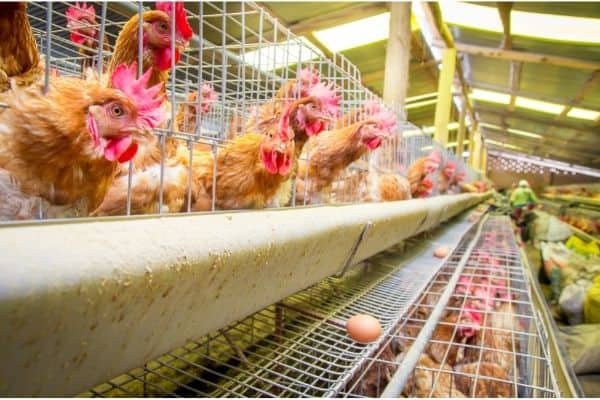
Layer farms require the separation of chicks, pullets, and layers. If you have a large rotation of egg layers in various life stages, you may need three separate barns.
What Equipment and Technology are Needed?
Both the dairy and poultry industries are becoming much more technological. Technology is freeing the hands of farmers while helping the livestock live in comfort.
Dairy Farm Equipment
The barns of today are often equipped with:
- Ventilation and Exhaust Fans
- Smart Cooling and Heating systems
- Robots
- Conveyor belts
and more
Dairies use automatic milking machines, some of which are entirely computer-controlled, and allow the cow to walk into the milking stall when she is ready. Other dairies still have milker machines put on the animal by hand.
Some freestall barns have automatic feeders that put feed out for the cows. They may also have hay sweepers that are like giant Roomba vacuums. The hay sweeper pushes the feed back into the trough, lessening the waste of feed.
Water systems are placed throughout the barns. Water is always needed and for many purposes.
Explore our most popular list of equipment
Poultry Farm Equipment
Poultry houses also have automatic feeding and watering systems.
Feeding equipment can be either manual or automatic. Shell grit boxes, adjustable linear feeders, and semi-automatic circular feeders are just three examples of feeding equipment.
Water supplies such as water softeners and water heaters, as well as plastic basins or automatic water dispensers are needed.
In addition, there are installed sensors and monitors to measure and adjust temperature and humidity. These will also control moveable panels that allow fresh air and sunlight into the barn.
Cleaning tools are essential to not only keep the poultry clean but the slaughtered animals and the slaughtering equipment clean.
How and What are the Animals Fed?
Another cost comes from the feed your flock or herd will eat, and the storage area needed to store that feed
There are differences in what the chickens will eat and what the cows eat. This extends to the life stage of the animals and what their purpose is.
Types of Feed for Dairy Animals
According to Dairy Discovery Zone, the dairy cow can eat 100 pounds of food a day.
It is vital that cows can feed on the right foods for the best milk production. Often, this means growing different varieties of nutrition for the cow to forage or hay.
Here are a few things the dairy farmer grows:
Types of Feed for Poultry Animals
Poultry farms have different grain mixes for the purpose of the chickens being farmed. There are many types of commercial feed available for the life stage and purpose of the farm-raised chicken.

Chicken Feed
It is interesting to note that though most large farms do not allow the chickens to free-range, it is not normal behavior or diet for a chicken to only eat grains. Chickens are omnivores by nature, and a genuinely free-range bird will supplement its grain food by eating:
Grain alone is not enough when it comes to the kind of protein and the amount that t chickens need.
Minerals from sources such as clams or oyster shells, gravel, bones, etc., are what they need to form most of the eggshells. Some of the sources are also rich in Vitamin D
Other types of feed include oats, wheat, corn, millet, barley, flax, and rye.
It is impractical to keep large flocks of free-range birds because it is difficult to control where they lay their eggs and what nutrients they are consuming.
check out
Our Buyers Guides
Our top picks for your Dairy Farming Needs
Dairy vs. Poultry: Which is More Profitable?
Both can bring in a profit, but determining which is more profitable requires a bit of exploration. Here are some statistics from the Dairy Cattle and Milk Production and Poultry and Egg Production for US from 2017 census of agriculture.
Dairy | Poultry | |
|---|---|---|
Number of Farms | 40,336 | 164,099 |
Number of Dairy Cows | 9.5 million | 8.9 billion |
Average Sales per farm | $1,122,724 | $1,133,207 |
Total Sales | $36.7 billion | $49.2 billion |
Average net cash farm income | $259,194 | $389,897 |
Average net positive income | 85% | 55% |
(source: https://www.nass.usda.gov/)
As we can see from the stats from 2017, there were more sales with a higher profit margin in the poultry industry. There were also four times as many poultry farms as compared to dairy farms.
According to study from Finbin, dairy farming begins to bring a profit when you have 200 to 500 cows and anything under 50 cows brings a loss to the farmer. This is due to the cost of feed and healthcare.
At the end of 2020, the income made by U.S. farms from dairy products was around $40.5 billion. (source: https://www.statista.com/)
Similarly, in 2020, the value of chickens, broilers and eggs made by U.S. farms for poultry products was around $30.35 billion. These stats are excluding value of Turkeys produced. (source: https://www.nass.usda.gov/)
Poultry farming is profitable for the backyard farmer to the mega-corporation. As a small poultry farmer, it is easy to profit from your fresh free-range eggs. The larger the farm, the more profitable it can become. But it is also more expensive to run.
The majority of large poultry farms are now contracted out to mega-corporations. The farmers build chicken barns and find a company to contract with. They receive chickens to care for while they are on the farm.
If they are layers, they will most likely spend the rest of their lives on that farm. If they are broilers, they will be taken to be butchered when they’ve reached the desired weight and age. Though the farmers raising the birds under contract are able to make a profit, it is the mega-corporation that actually owns the birds.
Dairy Farming vs. Poultry Farming
There are many differences between dairy and poultry farming, much more than can fit in this article. The highlights of dairy versus poultry are in dairy, you are raising mammals for the long-term production of milk, and poultry is raising domestic fowl for meat and or eggs.
In most cases, the poultry farm will not require as much land as a dairy farm. This is due to the animals' size and how they are kept and cared for. Commercially, both types of farming can be rewarding, but it is crucial to run a farm like any other business. You'll need to develop a business plan and get professional advice.
Like any other business, there is a demand fluctuation in both of these farming types. Farming animals of any kind is hard work that requires human interaction every day. In the end, through proper guidance, research, passion and hardwork, both dairy and poultry farming can be highly profitable.
This is not an Investment Advice
The Ideas and Strategies presented on this website and the information are based on our research and experience. These strategies are not intended to be a source of financial or business advice concerning the material presented. The information and/or documents contained on this website do not constitute investment advice. Any business idea or investment plan with financial risk should never be used without first assessing your own personal and financial situation or consulting a financial professional.
Sources:
https://www.dairydiscoveryzone.com/blog/home-sweet-home-3-popular-types-dairy-farms
https://rurallivingtoday.com/livestock/raising-goats-for-profit/
https://www.tractortransport.com/blog/dairy-farming-and-the-equipment-used/
https://agricfarming.com/list-of-poultry-farm-equipment/
https://www.watchusgrow.org/2019/06/19/hi-tech-barn-improves-cow-comfort/
https://www.poultryfarms.org/Poultry_Farms_Mena_AR_Types_of_Farms.html
https://poultryreporter.com/2019/12/15/two-types-of-poultry/
https://www.agriculture.com/livestock/poultry/when-and-how-to-start-a-poultry-farm
